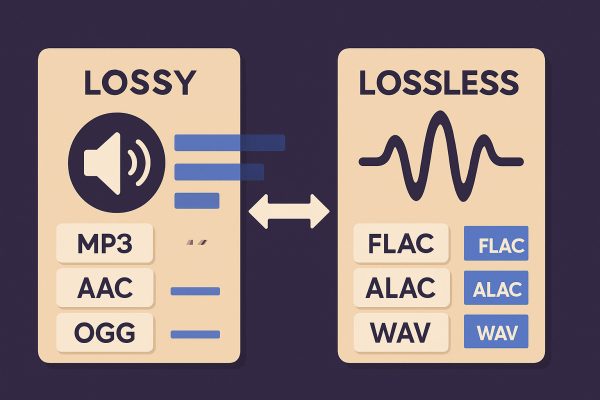Home>Production & Technology>What’s the Difference Between Lossy and Lossless Audio?


Production & Technology
What’s the Difference Between Lossy and Lossless Audio?
Modified: June 16, 2025
Understand the key differences between lossy and lossless audio formats, and when to use each for quality, storage, or compatibility.
(Many of the links in this article redirect to a specific reviewed product. Your purchase of these products through affiliate links helps to generate commission for AudioLover.com, at no extra cost. Learn more)
Table of Contents
Audio formats affect everything from how music sounds to how much space it takes up on your device. The core distinction lies between lossy and lossless compression—one prioritizes small size, the other preserves every detail. Whether you’re managing a personal library or prepping files for studio use, knowing which to choose matters. An audio converter becomes a key tool when switching between formats to balance quality, compatibility, and storage.
What Does “Lossy” Mean?
Lossy audio uses compression to reduce file size by permanently removing data from the original recording. The result is smaller files that are easier to store, share, and stream. But the trade-off is clear—some audio quality is sacrificed.
Common Lossy Formats:
-
MP3: Universally supported and efficient. Offers decent quality even at lower bitrates.
-
AAC (Advanced Audio Coding): Used by Apple. Better sound at similar bitrates compared to MP3.
-
OGG Vorbis: Open-source alternative, often used in gaming or streaming.
Benefits of Lossy:
-
Small file sizes
-
Faster streaming
-
Greater compatibility across platforms and apps
Downsides:
-
Audio degradation at lower bitrates
-
Lost details that can’t be recovered
-
Less suitable for editing or mastering
What Is “Lossless”?
Lossless audio keeps all original data intact. No frequencies are discarded. This format reproduces music exactly as recorded—bit for bit.
Common Lossless Formats:
-
FLAC (Free Lossless Audio Codec): Widely used, open-source, and compressed efficiently without losing any quality.
-
ALAC (Apple Lossless Audio Codec): Similar to FLAC but optimized for Apple devices.
-
WAV: Uncompressed and large. Used in professional audio work and CD recordings.
-
AIFF: Developed by Apple, uncompressed, ideal for studio-grade audio.
Benefits of Lossless:
-
Pure, original sound
-
Ideal for archiving or editing
-
Keeps full frequency range
Downsides:
-
Larger file sizes
-
Takes up more storage
-
Slower to upload or stream
Side-by-Side Comparison
| Feature | Lossy | Lossless |
|---|---|---|
| File Size | Small | Large |
| Sound Quality | Reduced (varies) | Original fidelity |
| Editing | Limited | Full-quality mastering |
| Compatibility | Very high | Moderate to high |
| Use Cases | Streaming, portable | Archiving, studio work |
When Should You Use Lossy?
You’re building playlists for your phone. You care about fitting thousands of tracks in limited space. Streaming your favorite album on a flight? MP3 at 320 kbps will sound just fine. Lossy is also the go-to for podcasts, voice memos, and casual listening where file size matters more than studio-grade quality.
When Should You Use Lossless?
You’re producing a track, remastering an album, or collecting rare concert recordings. Lossless formats like FLAC or ALAC preserve everything. Every snare hit, every whisper of reverb—intact. If you want to hear music the way it was recorded, unfiltered and full, lossless is your baseline.
Converting Between Formats
There’s no way to recover lost data once you convert to lossy. That’s why it’s better to convert music formats from lossless to lossy—not the other way around. A FLAC to MP3 conversion will shrink the file and make it portable, but don’t expect to regain quality by converting an MP3 into FLAC.
Need to batch convert FLAC files to MP3 for your phone? Use a FLAC converter. Have a podcast in WAV that needs to go online fast? A WAV converter trims the bulk while keeping the speech clear. Prefer M4A for your iPhone? A dedicated M4A converter bridges that gap.
Final Notes
Don’t treat audio formats as just tech jargon. They shape your entire listening experience. If you want portability, lossy delivers. If you want purity, lossless stands firm. Understanding the difference gives you control—whether you’re streaming, storing, or mastering your sound.

